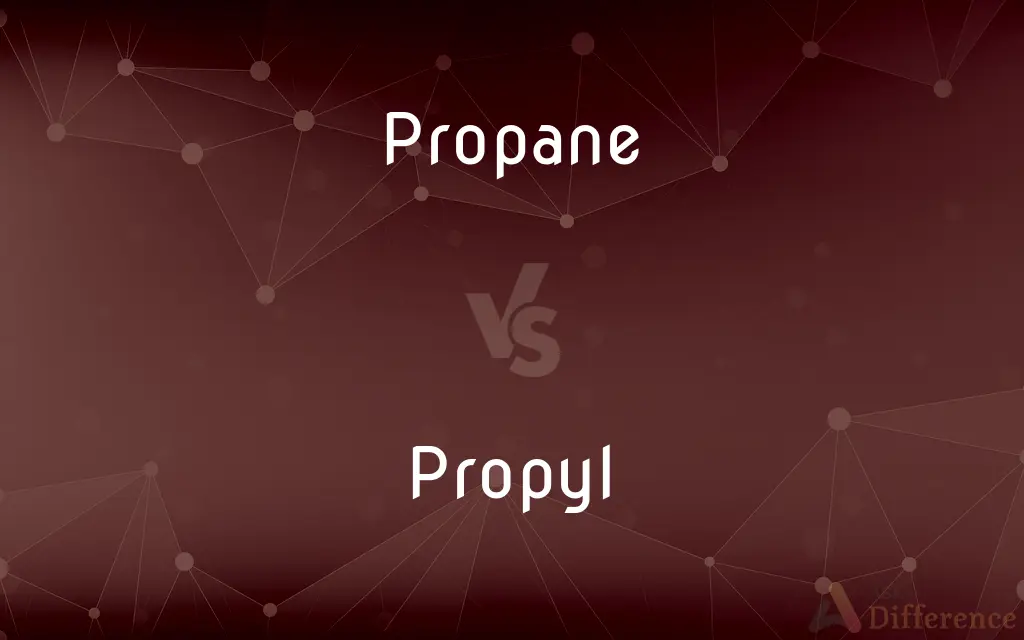Propane vs. Propyl — What's the Difference?
By Maham Liaqat & Fiza Rafique — Updated on March 7, 2024
Propane is a flammable hydrocarbon gas commonly used as fuel, whereas propyl refers to a hydrocarbon group attached to molecules, affecting their properties.

Difference Between Propane and Propyl
Table of Contents
ADVERTISEMENT
Key Differences
Propane is a three-carbon alkane with the molecular formula C3H8, widely used as a fuel in heating, cooking, and as a fuel for engines. It is a gas at room temperature but compresses into a transportable liquid. On the other hand, propyl is a functional group or side chain in organic chemistry, consisting of three carbon atoms attached linearly. It can be bonded to molecules to form larger compounds, influencing their physical and chemical properties.
Propane is extracted through the processing of natural gas and the refining of petroleum. It's stored and transported in liquid form under pressure in cylinders or tanks. Whereas, propyl groups are incorporated into various organic compounds during the synthesis process, altering the compounds' solubility, boiling point, and reactivity.
When combusted, propane releases energy, making it a valuable fuel source for heating and cooking. It burns cleanly with minimal pollution. In contrast, the presence of a propyl group in a molecule doesn't contribute to energy production but can significantly affect the molecule's chemical behavior and interaction with other substances.
Safety measures for handling propane include proper storage in approved containers and ventilation to prevent accumulation of gas, which can be explosive. Meanwhile, the handling of propyl-containing compounds depends on the specific chemical properties of the compound, which can range from relatively safe to highly toxic or reactive.
Propane's economic impact is significant, providing an essential energy source in areas without access to natural gas pipelines. Propyl groups, while not an energy source, are crucial in the pharmaceutical, plastics, and synthetic organic chemistry industries, highlighting their importance in manufacturing and product development.
ADVERTISEMENT
Comparison Chart
Basic Definition
A three-carbon alkane gas used as fuel.
A three-carbon functional group attached to molecules.
Use
Fuel for heating, cooking, and engines.
Alters properties of molecules in synthesis.
Physical State at Room Temperature
Gas (liquefied for transport).
Part of liquid or solid compounds.
Environmental Impact
Clean burning with minimal pollution.
Depends on the compound it's part of; varies.
Safety
Requires proper storage and ventilation.
Safety depends on the chemical properties of the compound.
Compare with Definitions
Propane
A colorless, easily liquefied gas used as fuel.
Propane tanks are commonly found in backyard grills.
Propyl
A functional group in organic chemistry with the formula -C3H7.
Propyl alcohol is used in a variety of industrial applications.
Propane
A hydrocarbon with the formula C3H8.
Propane is used in both liquid and gas forms for heating.
Propyl
Used in the production of plastics and chemicals.
Propyl compounds play a role in manufacturing flexible plastics.
Propane
Can be found in natural gas and petroleum.
Propane is separated from natural gas through a refining process.
Propyl
Alters physical and chemical properties of molecules.
Adding a propyl group can increase a substance's solubility in fats.
Propane
Utilized in portable stoves and heaters.
Camping trips often rely on propane for cooking and warmth.
Propyl
Found in various organic compounds.
The presence of a propyl group affects the compound's boiling point.
Propane
A source of energy for many rural areas.
Rural homes use propane for heating due to the lack of natural gas infrastructure.
Propyl
Important in the synthesis of pharmaceuticals.
Propyl groups are often introduced in drug molecules to modify their activity.
Propane
Propane () is a three-carbon alkane with the molecular formula C3H8. It is a gas at standard temperature and pressure, but compressible to a transportable liquid.
Propyl
Relating to or being a hydrocarbon unit, C3H7, that can occur as a substituent in an organic compound or as an ion or radical.
Propane
A colorless gas, C3H8, found in natural gas and petroleum and widely used as a fuel.
Propyl
(organic chemistry) Either of two isomeric univalent hydrocarbon radicals, C3H7, formally derived from propane by the loss of a hydrogen atom.
Propane
(organic compound) An aliphatic hydrocarbon, C3H8, a constituent of natural gas.
Propyl
The hypothetical radical C3H7, regarded as the essential residue of propane and related compounds.
Propane
A heavy gaseous hydrocarbon, C3H8, of the paraffin series, occurring naturally dissolved in crude petroleum, and also made artificially; - called also propyl hydride.
Propyl
The monovalent organic group C3H7- obtained from propane
Propane
Colorless gas found in natural gas and petroleum; used as a fuel
Common Curiosities
Can propane be used indoors?
Yes, with proper ventilation and safety precautions.
What does propyl refer to?
Propyl refers to a three-carbon functional group attached to organic molecules, influencing their characteristics.
Is propane a liquid or a gas?
Propane is a gas at room temperature but is often stored and transported as a liquid under pressure.
What is propane?
Propane is a flammable hydrocarbon gas used primarily as fuel.
How is propane used?
It's used for heating, cooking, and as fuel for engines and portable stoves.
Where is the propyl group found?
In various organic compounds, altering their properties like solubility and boiling point.
Are propyl-containing compounds safe?
Safety varies widely depending on the specific compound and its properties.
Is propane environmentally friendly?
Propane burns cleaner than many fuels, producing fewer pollutants.
What are common safety measures for propane?
Proper storage, handling, and ensuring good ventilation to prevent gas accumulation.
How does the presence of a propyl group affect a compound?
It can change the compound's boiling point, solubility, and chemical reactivity.
What makes propyl groups important in chemistry?
They are crucial in altering the physical and chemical properties of compounds for desired applications.
Why add a propyl group to a molecule?
To modify its reactivity, solubility, or other chemical properties.
What industries use propyl groups?
Pharmaceuticals, plastics, and synthetic organic chemistry.
How is propane obtained?
Through natural gas processing and petroleum refining.
Can both propane and propyl be used in energy production?
Propane is directly used as an energy source, while propyl groups influence the properties of compounds rather than producing energy.
Share Your Discovery

Previous Comparison
Jockey vs. Equestrian
Next Comparison
Alternate vs. SubstituteAuthor Spotlight
Written by
Maham LiaqatCo-written by
Fiza RafiqueFiza Rafique is a skilled content writer at AskDifference.com, where she meticulously refines and enhances written pieces. Drawing from her vast editorial expertise, Fiza ensures clarity, accuracy, and precision in every article. Passionate about language, she continually seeks to elevate the quality of content for readers worldwide.













































